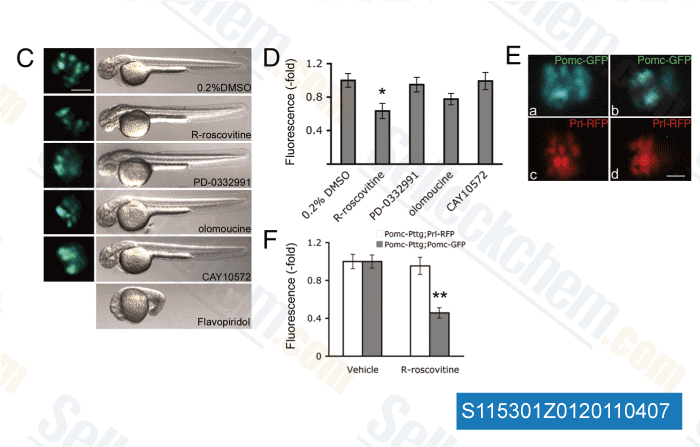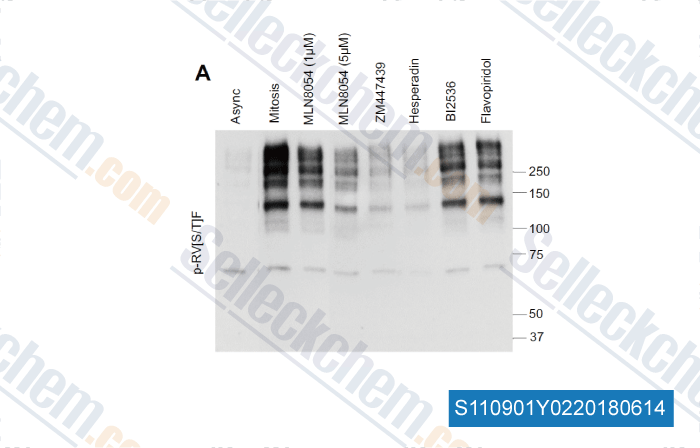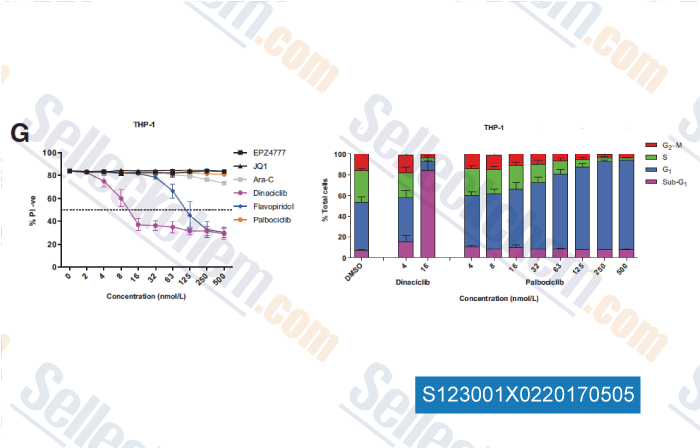|
Toll Free: (877) 796-6397 -- USA and Canada only -- |
Fax: +1-832-582-8590 Orders: +1-832-582-8158 |
Tech Support: +1-832-582-8158 Ext:3 Please provide your Order Number in the email. |
Technical Data
| Formula | C21H20ClNO5 |
|||
| Molecular Weight | 401.84 | CAS No. | 146426-40-6 | |
| Solubility (25°C)* | In vitro | DMSO | 30 mg/mL (74.65 mM) | |
| Water | Insoluble | |||
| Ethanol | Insoluble | |||
|
* <1 mg/ml means slightly soluble or insoluble. * Please note that Selleck tests the solubility of all compounds in-house, and the actual solubility may differ slightly from published values. This is normal and is due to slight batch-to-batch variations. * Room temperature shipping (Stability testing shows this product can be shipped without any cooling measures.) |
||||
Preparing Stock Solutions
Biological Activity
| Description | Flavopiridol (Alvocidib) competes with ATP to inhibit CDKs including CDK1, CDK2, CDK4, CDK6, and CDK9 with IC50 values in the 20-100 nM range. It is more selective for CDK1, 2, 4, 6, 9 versus CDK7. Flavopiridol is initially found to inhibit EGFR and PKA. Flavopiridol induces autophagy and ER stress. Flavopiridol blocks HIV-1 replication. Phase 1/2. | |||||||||||
|---|---|---|---|---|---|---|---|---|---|---|---|---|
| Targets |
|
|||||||||||
| In vitro | Flavopiridol displays less activity against unrelated kinases such as MAP, PAK, PKC, and EGFR with IC50 of >14 μM. Flavopiridol significantly inhibits the colony growth of HCT116, A2780, PC3, and Mia PaCa-2 cells with IC50 of 13 nM, 15 nM, 10 nM and 36 nM, respecitively. [1] Flavopiridol also potently inhibits the activity of Glycogen synthase kinase-3 (GSK-3) with an IC50 of 280 nm. [2] Compared with other CDKs, Flavopiridol inhibits the activity of CDK7 less potently with IC50 of 875 nM. Flavopiridol (0.5 μM) inhibits both pSer807/811 Rb and pThr199 NPM, whereas mild changes are observed at pThr821 Rb. Flavopiridol also decreases the overall RNA polymerase II level, as well as the phosphorylation of RNA polymerase II on the CTD repeats at Ser2 Ser5. [3] As a broad spectrum CDK inhibitor, Flavopiridol can inhibit cell cycle progression in either G1 or G2. Flavopiridol (0.3 μM) induces G1 arrest in either MCF-7 or MDA-MB-468 cells by inhibition of the CDK4 or CDK2 kinase activity. [4] Flavopiridol exhibits potent cytotoxicity against a wide variety of tumor cell lines with IC50 values ranging form 16 nM for LNCAP to 130 nM for K562. [5] | |||||||||||
| In vivo | Administration of Flavopiridol at 7.5 mg/kg for 7 days displays slight antitumor activity against P388 murine leukemia, resulting in %T/C value of 110, and active against the human A2780 ovarian carcinoma implanted sc in nude mice, producing 1.5 log cell kill (LCK). [5] Flavopiridol treatment at 1-2.5 mg/kg for 10 days significantly suppresses collagen-induced arthritis in mice in a dose-dependent manner, by inhibiting synovial hyperplasia and joint destruction, whereas serum concentrations of anti-collagen type II (CII) Abs and proliferative responses to CII are maintained. [6] In the p21-intact Hct116 xenografts in nude mice, administration of CPT-11 (100 mg/kg) followed by Flavopiridol (3 mg/kg) 7 and 16 hours later significantly inhibits tumor regression by 86% and 82%, respectively, displaying >2 fold inhibition compared with CPT-11 alone by 40 %. The combination produces ~30% complete response rate (CR) in contrast to CPT-11 alone where no CR is found. [7] | |||||||||||
| Features | First CDK inhibitor to be used in human clinical trials. |
Protocol (from reference)
| Kinase Assay: |
|
|---|---|
| Cell Assay: |
|
| Animal Study: |
|
References
Customer Product Validation

-
Data from [PNAS, 2011, 108, 8417]

-
Data from [Data independently produced by , , Science, 2018, 11(530), doi: 10.1126/scisignal.aai8669]

-
Data from [Data independently produced by , , Cancer Res, 2016, 76(5):1158-69]

-
Data from [Data independently produced by , , Oncotarget, 2018, 9(5): 6174-6187]
Selleck's Flavopiridol (Alvocidib) has been cited by 149 publications
| SLFN11-mediated ribosome biogenesis impairment induces TP53-independent apoptosis [ Mol Cell, 2025, S1097-2765(25)00042-5] | PubMed: 39909041 |
| Identification of modulators of the ALT pathway through a native FISH-based optical screen [ Cell Rep, 2025, 44(1):115114] | PubMed: 39729394 |
| Bacterial ubiquitin ligase engineered for small molecule and protein target identification [ bioRxiv, 2025, 2025.03.20.644192] | PubMed: 40166235 |
| Topoisomerase I is an evolutionarily conserved key regulator for satellite DNA transcription [ Nat Commun, 2024, 15(1):5151] | PubMed: 38886382 |
| ZIC2 and ZIC3 promote SWI/SNF recruitment to safeguard progression towards human primed pluripotency [ Nat Commun, 2024, 15(1):8539] | PubMed: 39358345 |
| Mapping nucleosome-resolution chromatin organization and enhancer-promoter loops in plants using Micro-C-XL [ Nat Commun, 2024, 15(1):35] | PubMed: 38167349 |
| HIRA protects telomeres against R-loop-induced instability in ALT cancer cells [ Cell Rep, 2024, 43(11):114964] | PubMed: 39509271 |
| Activity-assembled nBAF complex mediates rapid immediate early gene transcription by regulating RNA polymerase II productive elongation [ Cell Rep, 2024, 43(11):114877] | PubMed: 39412992 |
| PRMT1 promotes epigenetic reprogramming associated with acquired chemoresistance in pancreatic cancer [ Cell Rep, 2024, 43(5):114176] | PubMed: 38691454 |
| Monoallelically expressed noncoding RNAs form nucleolar territories on NOR-containing chromosomes and regulate rRNA expression [ Elife, 2024, 13e80684] | PubMed: 38240312 |
RETURN POLICY
Selleck Chemical’s Unconditional Return Policy ensures a smooth online shopping experience for our customers. If you are in any way unsatisfied with your purchase, you may return any item(s) within 7 days of receiving it. In the event of product quality issues, either protocol related or product related problems, you may return any item(s) within 365 days from the original purchase date. Please follow the instructions below when returning products.
SHIPPING AND STORAGE
Selleck products are transported at room temperature. If you receive the product at room temperature, please rest assured, the Selleck Quality Inspection Department has conducted experiments to verify that the normal temperature placement of one month will not affect the biological activity of powder products. After collecting, please store the product according to the requirements described in the datasheet. Most Selleck products are stable under the recommended conditions.
NOT FOR HUMAN, VETERINARY DIAGNOSTIC OR THERAPEUTIC USE.
